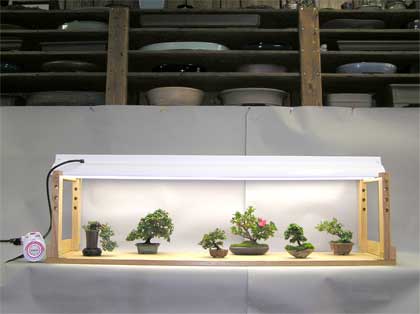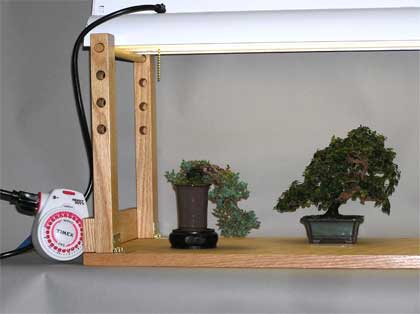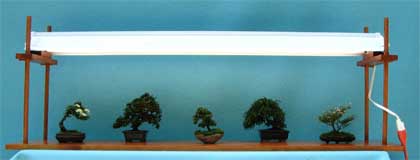
|
Indoor Bonsai - As Difficut As You Make It |
|
By Jack Wikle, Ann Arbor, Michigan |
|
Introduction So, can bonsai be grown indoors? Certainly. You can do this if you really want to . . . probably more easily than you think. Visit the Fuku-bonsai.com website and read about David Fukumoto's "True Indoor Bonsai." These trees are almost foolproof plants adapted to long term survival with minimal care at very low light levels. Then, at the other extreme, re-read Jerry Meislik's account (this website) of how he grows banyans and other tropical species luxuriantly under high-output metal-halide lights. And, finally, read my fluorescent light bonsai recipe offered below for one more option. Of course, yet another possibility is to grow bonsai indoors keeping them close to a window in an effort to provide enough light. Weighing these options and keeping the fundamental choice in mind, it shouldn't be too difficult to settle on a level of involvement that will fit you and your circumstances. Before going farther we need to make clear that growing bonsai is not doing lifeless models using sticks or clay. Bonsai are living trees or shrubs or, in some cases, even vines grown to look like trees. So, growing bonsai is partly horticulture, the nurturing of living plants. But, at its best, bonsai also involves artistic effort, the cultivation of trees as an aesthetic statement . . . as living sculpture. Certainly, the ongoing close involvement with living plants this implies is one of the great appeals of the bonsai hobby for many enthusiasts. Just be aware that most bonsai are not houseplants watered every week or so as the mood strikes and fertilized on whim. To paraphrase one of my old professors, who enjoyed tinkering with growing chrysanthemums as bonsai years ago, "Bonsai is not just watching plants grow, you get to do something with them." So, if the thought of giving regular attention, like having a pet, and the need for a little bit of patience in finding out what will work for you is exciting rather than threatening, the rest doesn't have to be that difficult. Keep reading! It is amazing how much one can do in very limited space, with minimal equipment and no natural light. Light Purchasing an economical timer to turn the lights on and off while giving your trees 16 hours of light each day eliminates the hassle of remembering to do this on schedule. Study the photos accompanying this article. The closer you can keep your trees to the fluorescent tubes the better they will grow. Water As a starting point, a misting bottle or a basting syringe will be adequate for applying water to the soil surface until it runs freely from the bonsai pot's drain hole(s). The flushing or leaching that takes place in liberal watering is important in preventing buildup in the soil of excess salts and other toxins. Successful bonsai growers are usually attentive bonsai growers who check their bonsai daily and water thoroughly whenever the soil surface seems to be getting somewhat dry. Indoors, out of the sun and wind, it is very unlikely that waiting another day when in doubt will harm your tree. In most cases, the tree will be healthier if its soil is not kept constantly full of water . . . an alternating wetting and drying cycle works best. Fertilizer Soil Of course, purchasing packaged "bonsai soil" from a vendor is one way to go. (Ask who supplies soil to members of your local bonsai society or, easier perhaps, check the internet for sources.) If you are compelled to mix your own soil, I am convinced you could do a lot worse than trying my "secret" recipe: 1 part (volume) Starter Chicken Grit (granite particles available wherever livestock feed is sold), 1 part sphagnum peat (break it up well and use particles that will pass through a five mesh (five openings per inch) screen, and 4 parts Turface (a commercial baked clay product widely used in "conditioning" athletic fields). No matter what components you choose, your mix will almost always be improved if each ingredient is shaken over a standard window screen (sixteen openings per inch) and anything that goes through the screen is discarded. Getting rid of the small particles that fill the spaces between the large particles opens the soil up letting excess water escape and air enter the mix very quickly after watering. Air
Temperature Plant
Material Any fig (Ficus species) is a candidate for growing as fluorescent light bonsai. Some other genera the author has found to be especially rewarding as small bonsai in the environment described here are: Buxus, Cotoneaster, Cuphea, Hedera (especially small-leaved cultivars), Myrtus, and Pyracantha. Actually, azaleas (genus Rhododendron) will also thrive and bloom several times a year under fluorescent lights operated sixteen hours a day. For a more "evergreen" look, Chamaecyparis and Cupressus also grow well year around under cool white fluorescent light. And, in spite of the "common knowledge" that junipers cannot survive indoors with no outdoor vacations, I have two that have both grown relying solely on cool white fluorescent light --- on sixteen hours a day --- for more than twenty years. As a source of plants hard to come by in other ways, consider making a propagating box that will fit comfortably under your fluorescent fixture. As one possibility, envision a gallon size, rectangular, antifreeze container trimmed to half its original depth except for its four corners which are retained to support a polyethylene bag that will cover the container. Most of the things I have been growing have been rooted successfully in this kind of box - with drain holes - almost touching the fluorescent tubes. A rooting mix of half sphagnum peat and half vermiculite has worked well for me. Half sphagnum peat and half perlite is also popular as a propagating medium. Make sure the rooting medium is thoroughly moistened, insert cuttings, cover rooting box with a gallon size "Baggie," set it under your fluorescent lights and wait. When roots have formed, pot the rooted cuttings into individual containers. Getting
Away Remember Footnote
Note |




